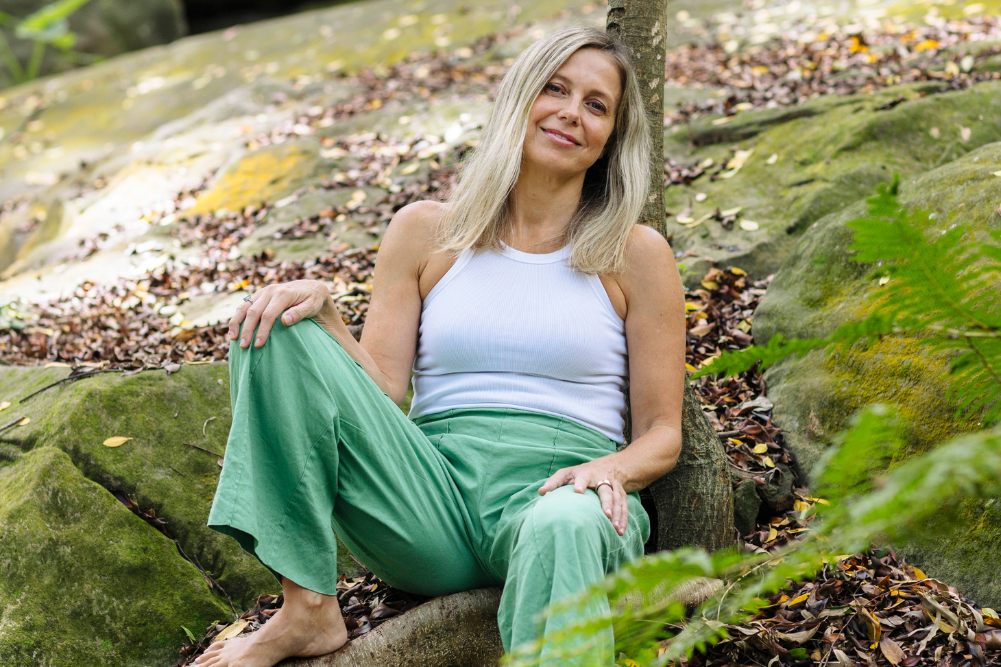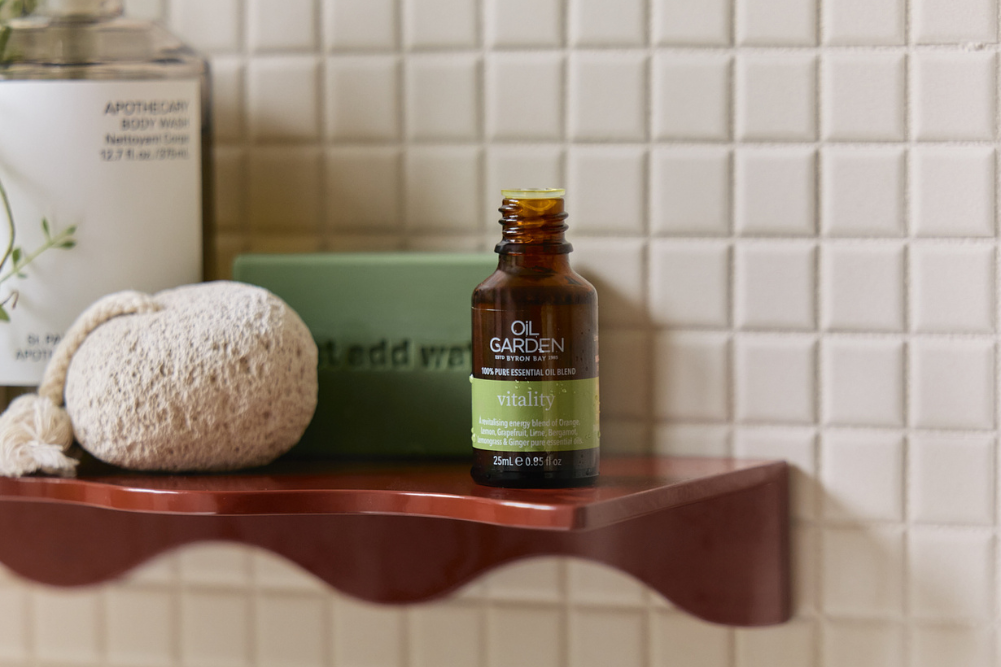Yoga for menopause
Perimenopause brings a whole new set of surprises, from midnight sweats to mood swings and insomnia. Yoga for menopause offers gentle but powerful tools drawn from ancient practices to help you navigate this journey and find steadier ground.
In recent years, it feels like the lid has been lifted on what was once a taboo topic, and now it’s the word on everyone’s lips… menopause. Instagram, TikTok and our bookshelves are full of it, and it seems impossible as a woman in her 40s to catch up with friends without it stealthily entering the conversation at some point. Growing up, I had no idea of what menopause was and certainly wasn’t interested in what it meant for those experiencing it, until I was well into my late 30s, headed towards the inevitable, myself. By my mid-40s, for the first time outside of puberty and pregnancy, my hormones were running wild, playing havoc with my body and mind. This was when I was introduced to the phenomenon known as “perimenopause”, the tricky time when your reproductive hormones including oestrogen are plummeting and the body is realigning itself to a new norm. Now it seems “peri”, as we call it, is the hot topic of every catch-up I have with my girlfriends, enthusiastically discussing the latest herbal supplements we are guzzling to prevent our disintegrating hair or get more sleep. The good news is that yoga can help us move through one of the most formative transitions of our lives.
What is menopause?
Menopause comes from the Greek word mens for months and pausis for cessation, when a woman’s monthly menstrual cycle ceases. After it has stopped for more than 12 months, she is postmenopausal. Technically, menopause is just one day, seemingly insignificant, but the perimenopausal time leading up to that day can stretch for many years and can feel anything but insignificant. The exact age varies but, for most women, it is a natural process of ageing that occurs in your 40s or 50s. However, for some, menopause may be brought on prematurely by medical or surgical procedures such as a hysterectomy or chemotherapy. Some women don’t even notice the process, while for others, it brings on extraordinary mental and energetic symptoms such as hot flushes, night sweats, anxiety and irritability, forgetfulness and brain fog, insomnia and pain, among others.
The research
For those who do find the symptoms challenging, there are various treatments available: pharmaceutical, hormonal and complementary. We now see a growing body of research suggesting yoga may be a highly effective option. A meta-analysis in Maturitas found that yoga significantly reduced menopausal psychological symptoms such as anxiety and depression. And a randomised controlled trial by the International Menopause Society demonstrated that yoga led to notable reductions in psychological, urogenital and somatic complaints.
The fall in oestrogen during menopause can increase the risk of heart disease and research highlights improvements in heart rate variability (HRV) when participants practice yoga. This is due to increased parasympathetic activity, (the cool, calm and collected aspect of your nervous system), which is associated with reduced cardiovascular risks.
An integrated approach
Yoga offers a holistic approach. Yoga physiology describes the systems the ancient yogis used to explain how energy moves through you. One model, the koshas, sees the body as a container (uphadhi) with sheaths or layers (each one called a kosha), all of which make up who and what you are – the physical, emotional, mental, spiritual and energetic aspects of the self. All the layers affect one another. When there are physical transformations, like the chemical changes from the radical hormonal shift in menopause, it is going to affect all the other layers too, ie sluggish energy, brain fog and mental health issues. According to research done at Monash University, an estimated 40 per cent of perimenopausal women experience depressive symptoms, with symptoms often worse in severity compared to depression in younger and older women.
By targeting the physical layer and practising the asana or poses, moving your body more consistently naturally starts to shift all the layers. You feel better in your body and perhaps make more nourishing food and drink choices, you have more energy and your mental health improves. By focusing on the mental layer, and practising meditation, you may find your thoughts settle, you are more willing to move the body and on the loop goes. When you chant, endorphins may be released, improving your mood, and it may reset the vagus nerve (VN), which controls the bulk of the parasympathetic nervous system. Resetting the VN can help menopausal symptoms such as anxiety and insomnia. In addition to chanting, slowing down the breath, or stimulating the throat by taking ujjayi breath as well as other yogic practices can target the VN.
Ayurveda and menopause
Ayurveda, or “the science of life”, has been used to manage the symptoms of menopause for thousands of years. Ayurveda refers to menopause as rajonivritti, where rajah means menstrual blood and vritti means cessation. Considered the sister science to yoga, Ayurveda originates from the same Vedic system of wellness. Though ancient Ayurvedic texts didn’t refer to menopause in the same way Western medicine does, the physiological and emotional changes associated with this stage of life were recognised and categorised under principles of ageing and “doshic” imbalances.
In Ayurveda, doshas are the forces that govern the physical and mental processes of the body. They are made up of the five elements (earth, water, fire, air and space) and form the foundation of everyone’s constitution. The three doshas are Vata (air and space), Pitta (fire and water) and Kapha (earth and water), and each has specific qualities, functions and imbalances.
Ayurveda views menopause as a natural phase and believes that the associated symptoms are attributed to imbalances in the body’s doshas. An increase in Vata dosha is considered the major imbalance during this phase and is linked to common symptoms including hot flushes, insomnia and mood swings, though Pitta (hot flushes) and Kapha (sluggish digestion and energy) imbalances also play roles.
Ayurvedic practices that pacify Vata are considered highly beneficial. These include diet and lifestyle recommendations, oil massage and cleansing rituals.
A diet focusing on warm, cooked foods, avoiding cold or raw items and incorporating sweet, sour and salty tastes can calm Vata. So can establishing a regular daily routine to provide stability or engaging in gentle yoga and walking to support the physical body. Meditation and pranayama, and taking herbs like immune-building ashwagandha, or shatavari for hormonal health, are also prescribed among other suggestions.
Practice
With a focus on parasympathetic nervous system engagement and calming Vata during menopause, the most beneficial yoga practice is a slower, grounding, restorative one. However, the system can get sluggish, as can bone density and weight gain, so a little bit of strength work is required. The practice below incorporates poses that target some common menopause challenges with all the above in mind. Use props such as bolsters, blocks, straps and blankets to make it more accessible and comfortable.
Standing poses
Standing poses build stamina, strength and resilience, maintain bone density and help us feel grounded. Try one or all.
Extended side angle pose
Step right foot forward. Set the front knee over front heel, back heel over ball of foot. Spin the back heel down. Peel the right hip back in line with the knee. Take the right elbow to thigh or right hand to a block placed at the outer edge of right foot behind the heel. Spin right ribs under, left ribs on top. Reach left arm and fingers forward. Take a few breaths. Swap to the other side.
Half-moon pose
Take the block on a higher setting and set it forward. Place right hand on block under shoulder. Lift left leg up in line with hip and balance. If you need support, do it with your back against the wall. Take a few breaths. Swap to the other side.
Plank pose
Shoulders over wrists, heels over balls of feet, the body in one long line. Lift shoulders out of wrists, pull the frontal hip bones to bottom ribs and firm the legs. Draw naval into spine. Place knees down if needed. Take a few breaths.
Easy twists
Twists may aid digestion and relieve bloating. Here are two gentle, seated variations.
Hero’s pose twist
Bend the knees, sit on the heels and extend through the spine. Frame your shins with the left hand and twist to the right. If it feels better, extend the left leg. Take a few breaths and come back to centre. Over to the other side, extending the right leg if needed.
Sukhasana twist
Cross the legs, both shins parallel in front you, right shin in front. Sit on a prop if you need to or support the knees with props. Twist to the right, taking left hand to outer edge of right thigh. Take a few breaths. Swap legs so left shin is in front. Twist to the left and take a few breaths. Come back to centre.
Heart openers
Heart openers may improve circulation, open the chest and stimulate the thyroid and adrenal glands, bringing hormonal balance.
Supported bridge
Lying on back, lift hips up and place a block or bolster underneath. Allow the pelvis to melt down into the support. Take some slow, deep breaths.
Reclined heart opener
Place buttocks on the floor with upper body lying on a bolster or pillows. Allow the chest and upper back to open. Extend legs or keep soles of feet together with knees out to the side for a hip opener. Take some slow, deep breaths. For a deeper option use blocks, one under the thoracic spine and one under the head.
Seated forward folds
Gentle seated forward folds may promote relaxation, reduce stress and help manage hot flushes and mood swings. The hip openers may help to reverse the tightening of hips that can occur in menopause.
Wide-angled seated forward bend
Sitting with a tall spine, extend the legs and set them about 90 degrees apart. Flex the feet, toes pointing straight up. Stay upright or lean back on a wall or against a couch. Or hinge forward from the hips, keeping the seat connected to the earth and the spine long. Use a bolster or pillow on a chair to support the upper body. Take a few breaths.
Tarasana
Bend knees into your chest and allow them to open out to the side. Create a diamond shape with the legs. Curl forward, allowing the spine to curve. Soften the shoulders, face and jaw. Rest your forehead on a prop. Close the eyes, relax the body and shift awareness to the breath. Take a few conscious breaths.
Pranayama and meditation
Sheetali pranayama
This cools the mind and body (including hot flushes).
Sit with a tall spine, take a slow breath in and out. You can always lean against a wall, sit on a bolster or pillow or on a chair if it’s more comfortable. Curl the tongue up like a straw (not everyone can do this, so don’t worry if you can’t) and slowly inhale through the rolled tongue, close the mouth as you exhale through the nose. Drop the practice if it doesn’t feel easeful. Repeat a few times.
Alternate nostril breathing
Helpful to balance and restore a state of calm.
Still seated, place the right thumb on right side of nostril, gently close it off as you inhale slowly through the left, use your pinky to close off the left and exhale right. Inhale right, close off right and exhale left. Inhale left, close off left and exhale right. Continue in this way for a few rounds, finishing by exhaling on the right. Return to breathing as normal.
Open awareness meditation
Fosters emotional stability.
Sit or lie down in a comfortable place and start by listening to the sounds around you. See if you can drop the separation between “you” and “listening”. As you notice thoughts arise, let them bubble up and then, importantly, let them float away. Expand your awareness to feel the air around you, the temperature, the breath, physical sensations, smells, taste, everything. As thoughts and feelings come up, feel them and then let them melt away.
To finish
Legs up the wall to savasana
Restorative poses reduce stress and tension and promote sleep. Lie on your back, with legs up the wall. Bend knees, press feet into wall to lift the pelvis. Slide a pillow or folded blanket under the pelvis and place it back down. Extend the legs up. You can stay here for as long as it’s comfortable. To come out, bend knees, press feet into wall, lift hips up to remove prop, roll over to one side pausing for a few breaths, using hands under head as a pillow. Then stretch out to lie on your back.








